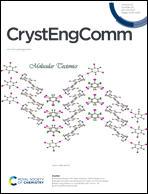Post-synthetic modification of supramolecular assemblies of β-diketonato Cu(ii) complexes: comparing and contrasting the molecular topology by crystal structure and quantum computational studies†
Abstract
The post-synthetic approach is a powerful strategy to modify organic linkers and/or metal node functionality without disrupting the parent metal and ligand coordination. Engineering new crystal forms of the same molecule and investigating the relationship among them is a challenging area of crystallography to explore the structure–property relationship. In this regard, a new crystal form of homoleptic 4,4,4-trifluoro-1-(2-naphthyl)-1,3-butanedione (TFNB) Cu(II) complex [Cu(TFNB)2(C2H6SO)] (1) is characterized by the single crystal X-ray diffraction method which revealed that complex 1 is an isostructural solvate of previously reported [Cu(TFNB)2(C2H6SO)2] (2). In complex 1, a single DMSO solvent molecule is apically coordinated to the Cu(II) ion to form a distorted square pyramidal geometry with two chelating rings of TFNB, while in complex 2, the solvent molecules are present in pairs related by the inversion center leading to a six coordinated octahedral geometry. Besides, the newly synthesized heteroleptic Cu(II) complex of TFNB with 8-hydroxyquinoline exists in two pseudopolymorphic forms, [Cu(TFNB)(8HQ)]2 (3) and [Cu(TFNB)(8HQ)]·CH3COOH (4) via non-bridging solvent incorporation. Complex 3 is a phenoxide bridged binuclear complex that adopts a distorted square pyramidal geometry. In complex 4, the bridging action of phenoxide is broken by the effect of a guest solvent (acetic acid) molecule, leading to the formation of a discrete mononuclear complex with a square planar geometry. The solvent induced structural transformations on the metal coordination sphere and molecular interaction topology of Cu(II) complexes, via single crystal coordinated solvent exchange (complexes 1 and 2) and solvent molecule participation in the crystal lattice (complexes 3 and 4), were comparatively analyzed and investigated by combined crystallographic and quantum computational studies.

- This article is part of the themed collection: Supramolecular & Polymorphism


 Please wait while we load your content...
Please wait while we load your content...